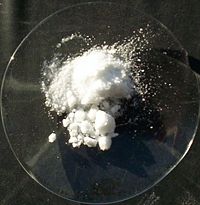Ammonium chloride
| Ammonium chloride | |
|---|---|
 |
|
| IUPAC name | Ammonium chloride |
| Identifiers | |
| CAS number | 12125-02-9 |
| Properties | |
| Molecular formula | NH4Cl |
| Molar mass | 53.49 g/mol |
| Appearance | White solid |
| Density | 1.527 g/cm3 |
| Melting point |
338 °C (decomposes) |
| Solubility in water | 29.7 g/100 g water at 0 °C |
| Thermochemistry | |
| Std enthalpy of formation ΔfH |
−75.179 kcal/mol[1] |
| Except where noted otherwise, data are given for materials in their standard state (at 25 °C, 100 kPa) Infobox references |
|
Ammonium chloride (NH4Cl) (also Sal Ammoniac, salmiac, nushadir salt, zalmiak, sal armagnac, sal armoniac, salmiakki, salmiak and salt armoniack) is, in its pure form, a clear white water-soluble crystalline salt of ammonia. The aqueous ammonium chloride solution is mildly acidic. Sal ammoniac is a name of natural, mineralogical form of ammonium chloride. The mineral is especially common on burning coal dumps (formed by condensation of coal-derived gases), but also on some volcanoes.
Contents |
Sources
The substance occurs naturally in volcanic regions, forming on volcanic rocks near fume-releasing vents. The crystals deposit directly from the gaseous state, and tend to be short-lived, as they dissolve easily in water.
Ammonium chloride is prepared commercially by reacting ammonia (NH3) with hydrogen chloride (HCl):
-
- NH3 + HCl → NH4Cl
Ammonium chloride is also found in volcanoes and deep underground.
Applications
Ammonium chloride is sold in blocks at hardware stores for use in cleaning the tip of a soldering iron and can also be included in solder as flux.
Other uses include a feed supplement for cattle, in hair shampoo, in textile printing, in the glue that bonds plywood, as an ingredient in nutritive media for yeast, in cleaning products, and as cough medicine. Its expectorant action is caused by irritative action on the bronchial mucosa. This causes the production of excess respiratory tract fluid which presumably is easier to cough up. It is also used in an oral acid loading test to diagnose distal renal tubular acidosis.
Ammonium chloride is used in snow treatment, namely on ski slopes at temperatures above 0 °C, to harden the snow and slow its melting.
In several countries sal ammoniac is used to spice up liquorice-type dark candies (Finland's salmiakki, Sweden's lakrisal, the Netherlands' zoute drop and the Danish Dracula Piller are popular examples), and as a flavoring for vodkas.
Ammonium chloride is used as an expectorant, diuretic and systemic acidifying agent. It is used in the treatment of severe metabolic alkalosis, to maintain the urine at an acid pH in the treatment of some urinary-tract disorders or in forced acid diuresis.
Ammonium salts are an irritant to the gastric mucosa and may induce nausea and vomiting.
Biological applications include using it as an energy source for microbiological growth of organisms.
See also
- Salty liquorice
- Salmiakki Koskenkorva
References
- ↑ Solid state data from Ammonium chloride in Linstrom, P.J.; Mallard, W.G. (eds.) NIST Chemistry WebBook, NIST Standard Reference Database Number 69. National Institute of Standards and Technology, Gaithersburg MD. http://webbook.nist.gov (retrieved 2008-10-22)
|
||||||||||||||||||||||||||||||||||||